In Turin, Italy, on the former site of Fiat company office buildings, a 63-unit apartment creates a living space is in the middle of an industrial area of the city, but doesn't feel that way. It is designed to house trees as well as people (and to end up looking and feeling like a tree house in the process). The building, 25 Verde (translated 25 “Green”) was designed by architect Luciano Pia. It was “finished” in 2012, but has continued to grow and change in the 12 years since—as things will do when they include living things as part of their structure.
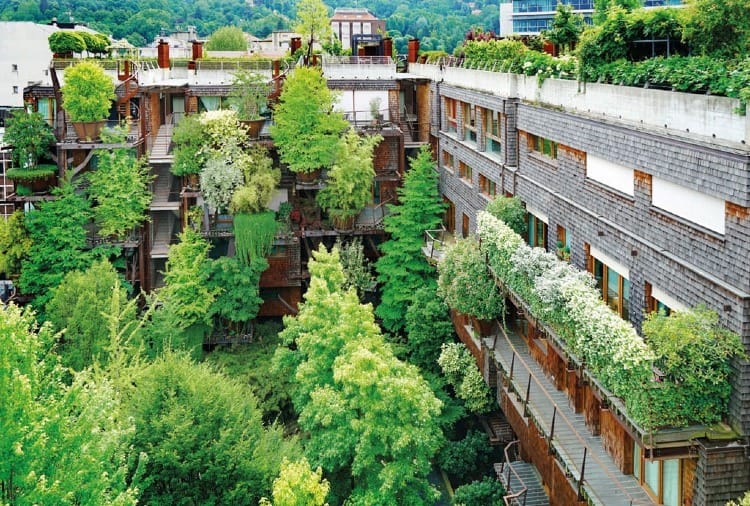
Design
The building is a U-shaped structure with a tree-filled center courtyard. There are 150 potted trees distributed around and within the facades. Some of these potted trees are on individual balconies; some are in common areas; some are on rooftops. The pots and plants vary in size and kind, providing visual variety as wells as fruit, flower, and habitat variety.
The inner courtyard holds an additional 50 trees as well as other plants. The courtyard planned to create a forest with four levels within in: large and medium trees, shrubs, and undergrowth. This area is raised three feet above the ground so that the trees are only physically accessible for maintenance and care. Residents can enjoy them from pathways, common sitting areas, or from balconies and other viewing areas.
The outside of the apartment structure is covered with larch shingles which are intended to be reminiscent of tree bark. They are untreated so that they have a natural look and varied colors as they age and weather, another way of creating the feeling for residents that they are living in the midst of trees.
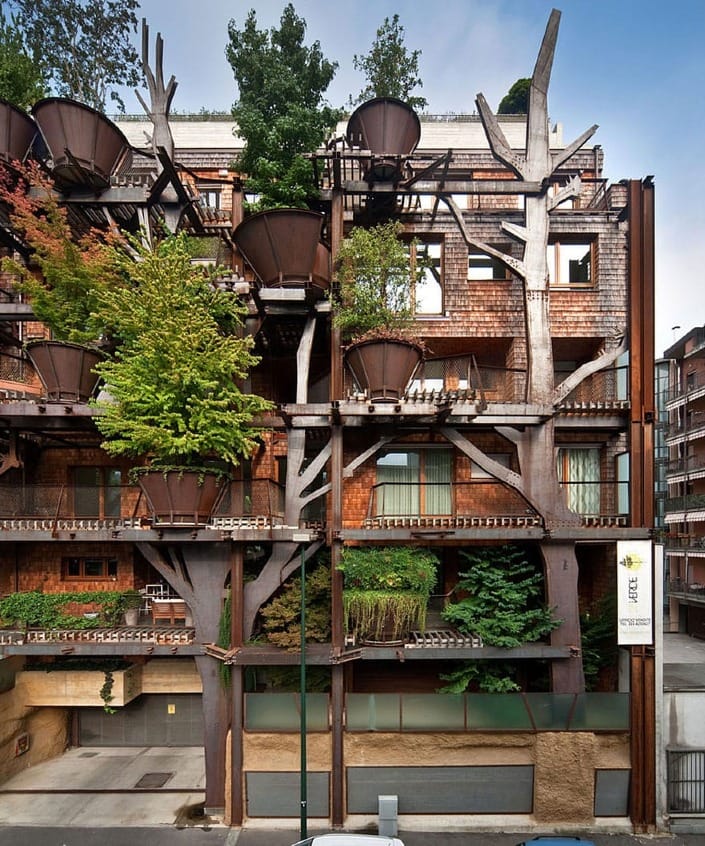
Along with the living trees and the wood products, there are other reminders of trees in the tree-shaped forms of steel pillars holding up some of the potted trees (the sculptured trees are also part of the irrigation system). The pillars were designed based on photographs of a tree promenade along a Turin boulevard—so that the shape and branching of the trees have forms that are lifelike and realistic.
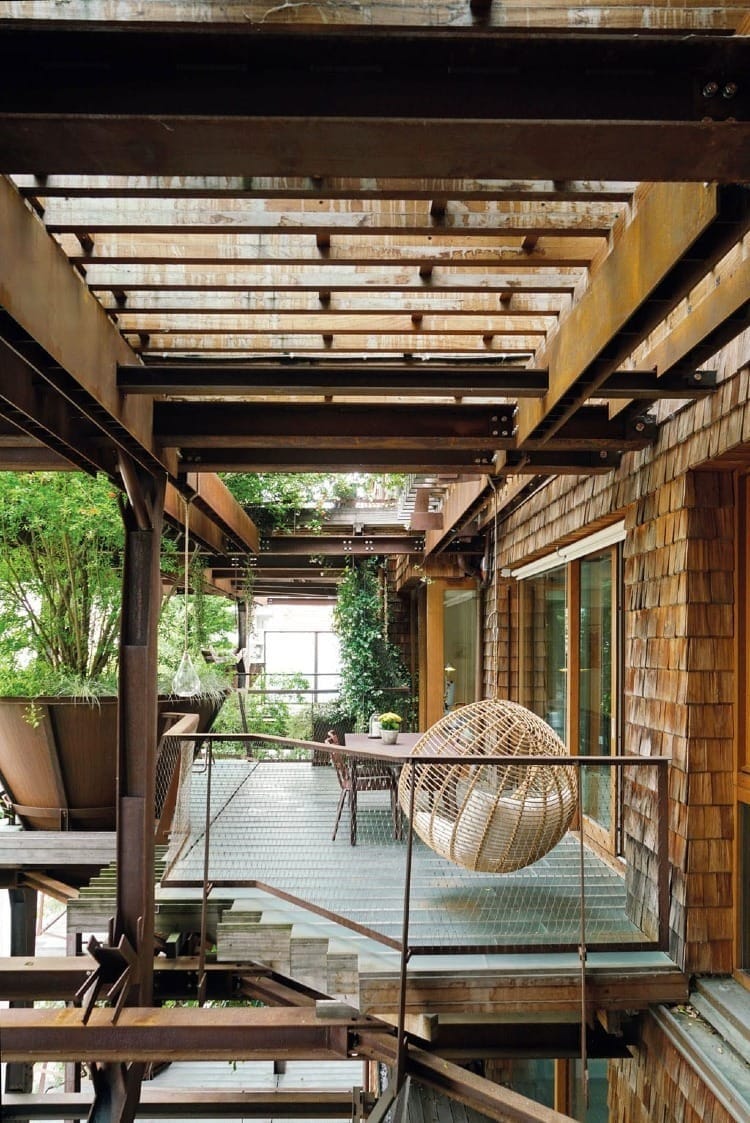
Each of the 63 living units is different from the others, but they do have traits in common. None have interiors walls; they all incorporate box-shaped elements, and the plumbing and wiring are contained on the side walls, leaving residents to personalize their own spaces. All have extensive balconies, with 40-45% of the square footage of the units being balcony space. Human residents often find squirrels and birds sharing the outdoor spaces.
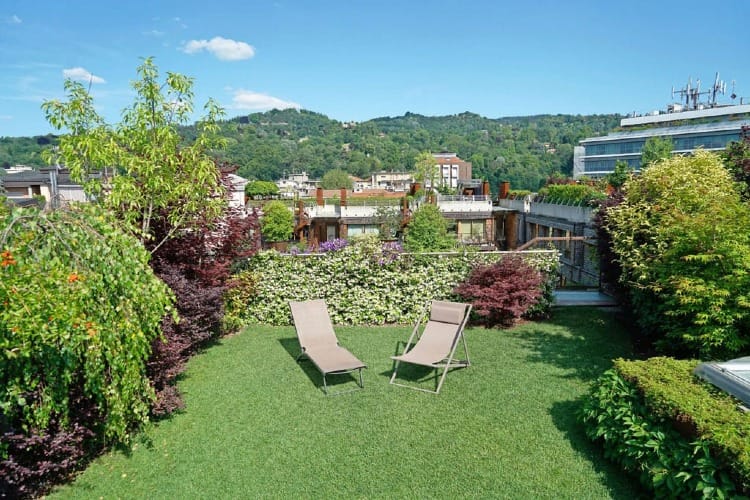
At the top of the building is a roof garden, divided into separate gardens for each of the residents of the top floor. Each of these is a private garden space which can include whatever type of garden they prefer: rose garden, fruit trees, vegetable garden, etc. The "soil" of these gardens is not dirt, but a porous material that allows water to percolate downward and be reused.
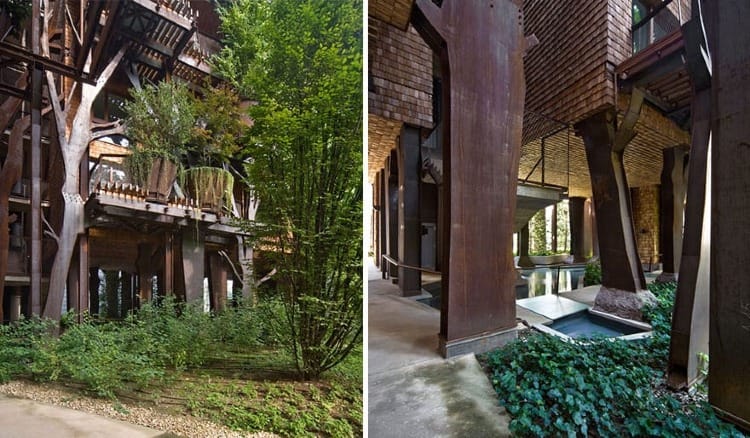
Courtyard pools provide a place to relax and gather, especially in the summer. Small catwalks extend over water surfaces, which are lined with green plants on the sides, intended to create the feeling of an oasis.
The wooden flooring on upper levels contains glazed openings, allowing light to penetrate and reach lower levels, giving needed light both to trees and to humans.
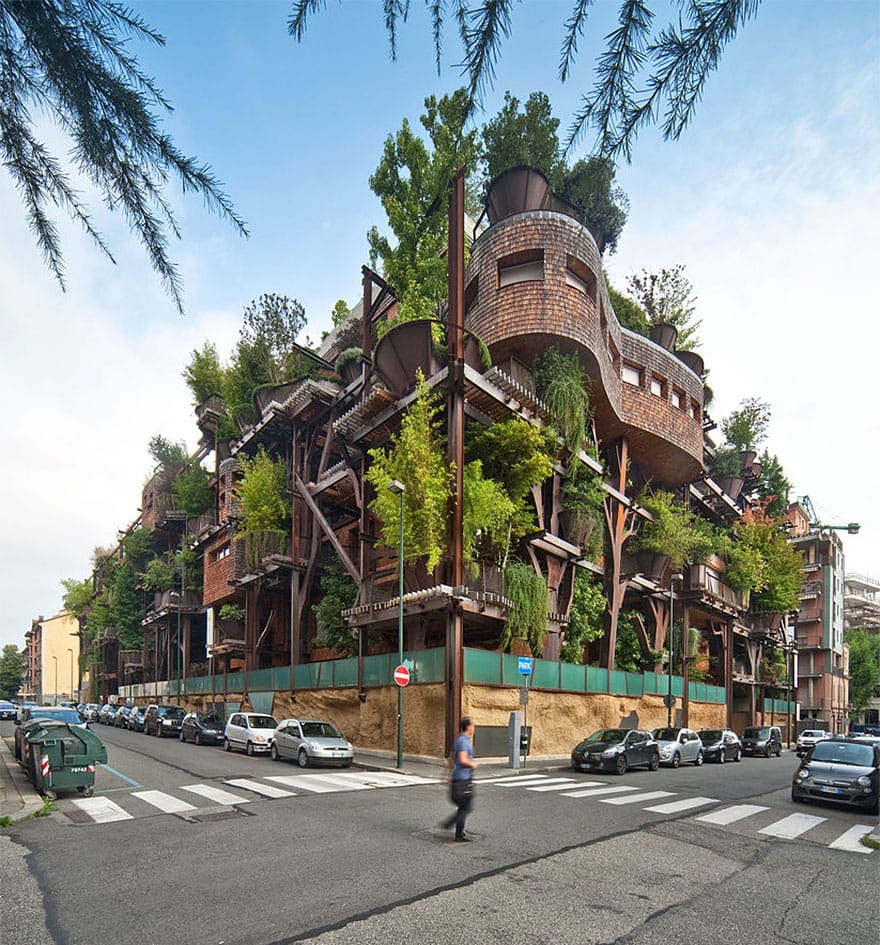
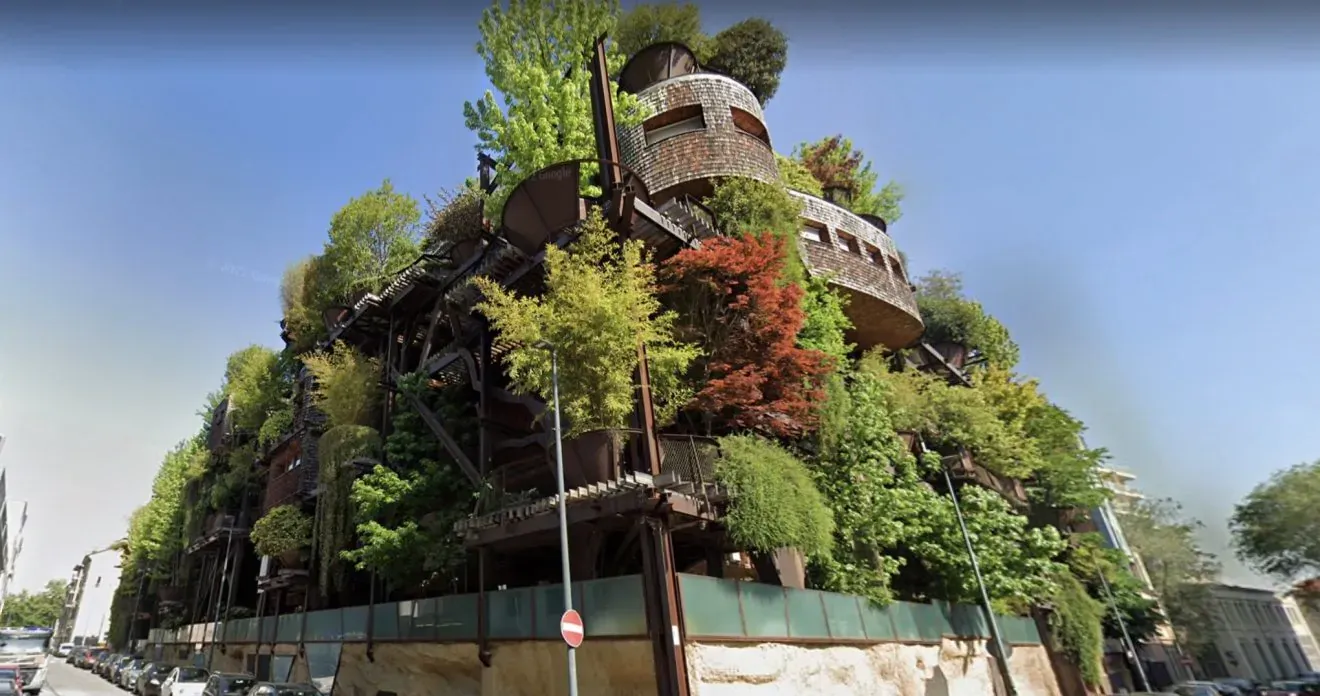
Corner of 25 Verde: Pictures from 2015 and 2024.
Terraces are staggered to create gaps for the trees to grow up into. In the two pictures above, which are taken nine years apart, the growth of the trees into those empty spaces is evident. According to Pia’s design, each of the trees has room to grow. “You have to plant them in pots sufficiently large to ensure the nutrition and root growth,” he says.
Planting and Care
Plants were chosen and placed by a Turin company named Lineeverdi based on their ability to adapt to particular conditions, their mature size, aesthetics, and variety. Changing colors, flowers, leaf variety were all considered and planned for. Some evergreens are included so that there is some consistent green structure no matter the season, but most are deciduous trees that give shade in the summer heat and allow more sunlight through during the winter months after the trees have lost their leaves.
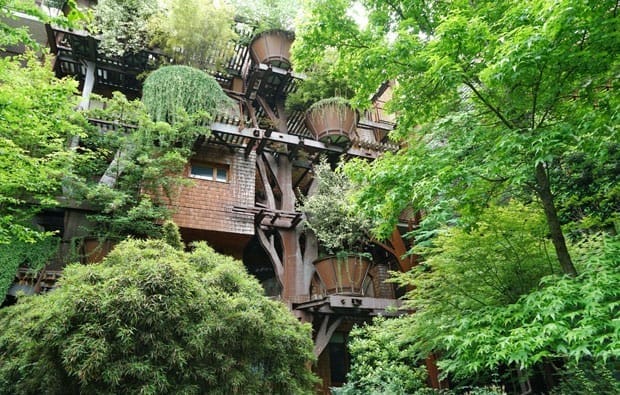
The plantings are in no way haphazard or random, but done purposefully. For instance, maple trees and bamboo are located in the interior where they have afternoon shade, while more sun-loving trees are placed on the south side where they receive direct sunlight all day long.
In originally preparing the trees for the transition to 25 Verde, great care was taken to encourage their ability to adapt. After being purchased from Tuscany, they were acclimated to Turin's particular conditions by being grown on hills nearby for a year, in the same soil composition they would have once potted. This gave them time to adjust to their new conditions, reducing the stress they would experience when transplanted to their current location.
Interestingly, the plants are considered part of the building structure—a feature held in common—which means that their care is solely the responsibility of the building maintenance crew, not the individual tenants. Trees are equivalent to architectural elements, so that replacing one requires authorization from the city. As cited in one article the company that chose the plants has said, “… we have not yet had to resort to any pruning, and no tree has died. They are healthy.”
Sustainability
The building is designed to function as an ecosystem, with the architect adopting measures coming from a biological idea of architecture. This shows up in various design elements.
Walls are thick and windows, although numerous, are insulated to help energy efficiency. Renewable energy, such as solar panels and geothermal energy heat pumps, are used to generate electricity and heat water.
Rainwater is collected at the top of the building. When the collectors are full, the water flows through the hollow steel "tree" trunks—joining the water filtering down from the rooftop gardens. The water ends up on the lower level where it can be used for irrigation, filling the pools, and other non-potable uses.
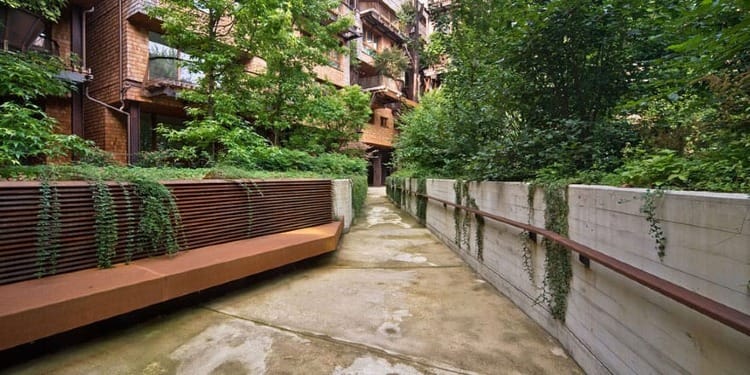
The trees also have practical as well as aesthetic purposes. For instance, they mitigate the temperature, lowering the temperature in the courtyard 4-5 degrees compared to the streets outside.
They also purify and freshen the air, which is particularly important since Turin is one of the most polluted cities within the European Union. The large number of industrial plants in Turin and its location within the Po Valley, which traps the pollution within its walls, make any pollution mitigation an important thing. The trees absorb five tons of CO2 per year.
Other Benefits
The trees also serve as a buffer from the noise and busyness of the city. Part of the aim of the project was to create a "flowing and smooth transition space to soften the passage from the inside to the outside."
As one resident described it, "The philosophy is connecting to the earth, the way it used to be. Man builds structures, they tend to be rigid, more and more disconnected from the earth. So, this is bringing a little bit of the way we used to live in a modern setting but some of the characteristics of the ancient way of living. We are forest creatures in a way."
The same resident described coming into the ground floor courtyard from the street in this way.
When you walk in you have this feeling, it quietens you. People...come in noisy and they step inside here and ...lower their voices. When you walk in, you have this feeling—it quietens you in a way. There is a quieting and sense of hushing...The effect we’re struggling for is to remind you of the presence of God.
The apartment complex aims to create community. This happens in the common area, where residents sometimes gather for concerts or other common events. In these shared areas, there are plants such as wild strawberries growing, which can be picked and turned into jam. Because 25 Verde is such a unique living space, there is a strong sense of belonging and a common interest in living sustainably that creates a unified identity.
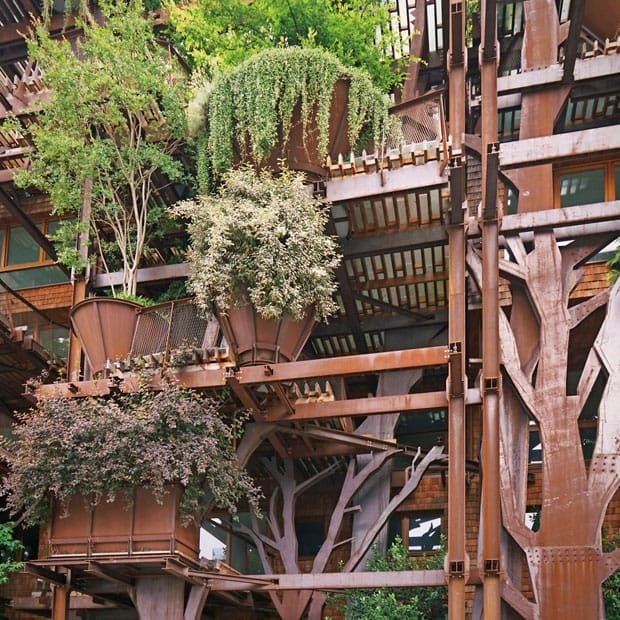
The trees are central to this identity. “I never tire of looking at how the trees change continually, they are the true inhabitants of this complex,” one of the residents has said. Living here encourages mindfulness of a person's lifestyle and people tend to become even more conscious of their effect on the environment after moving in.
Reflection Questions: Are you part of a "green" community that encourages and teaches you to live more ecologically? Are there ways in which you would like to make the inside of your home more connected to the world outside?
Below is a video in which residents of 25 Verde give a tour of the building and talk about their experiences of living here.
Feel free to leave a comment below or contact me directly at louise.conner@circlewood.online.
Louise
